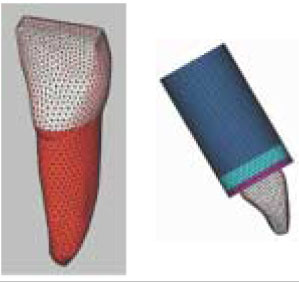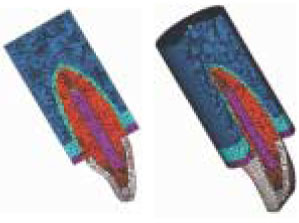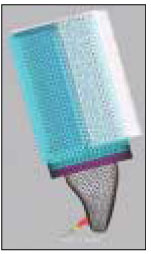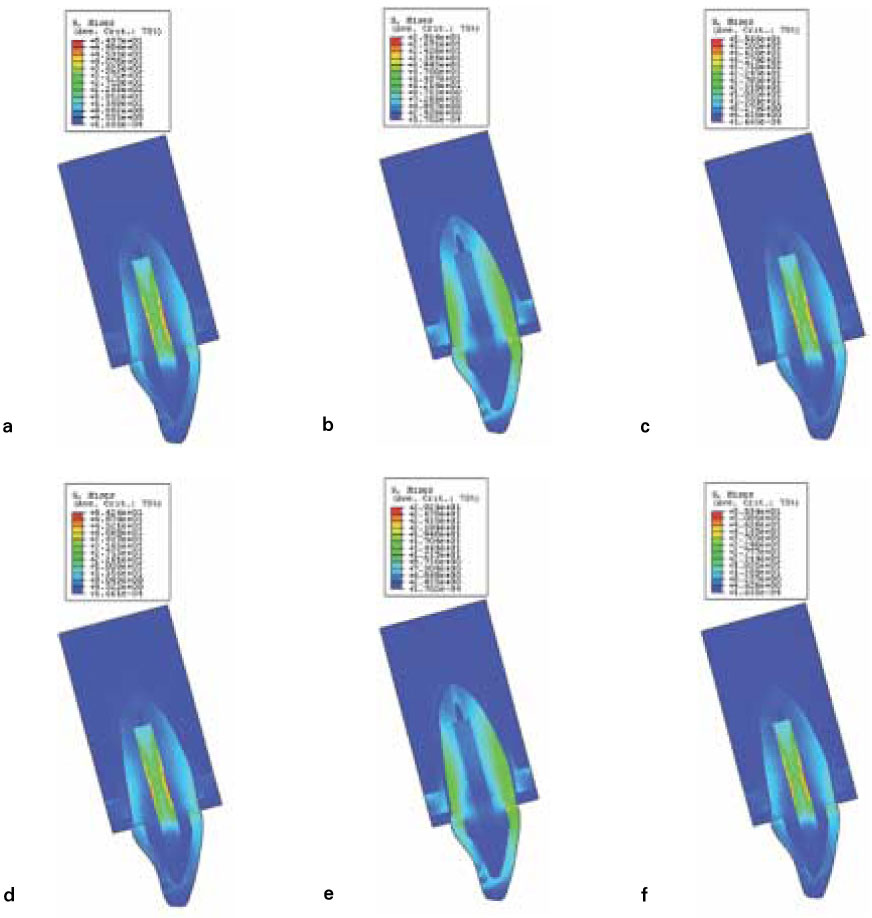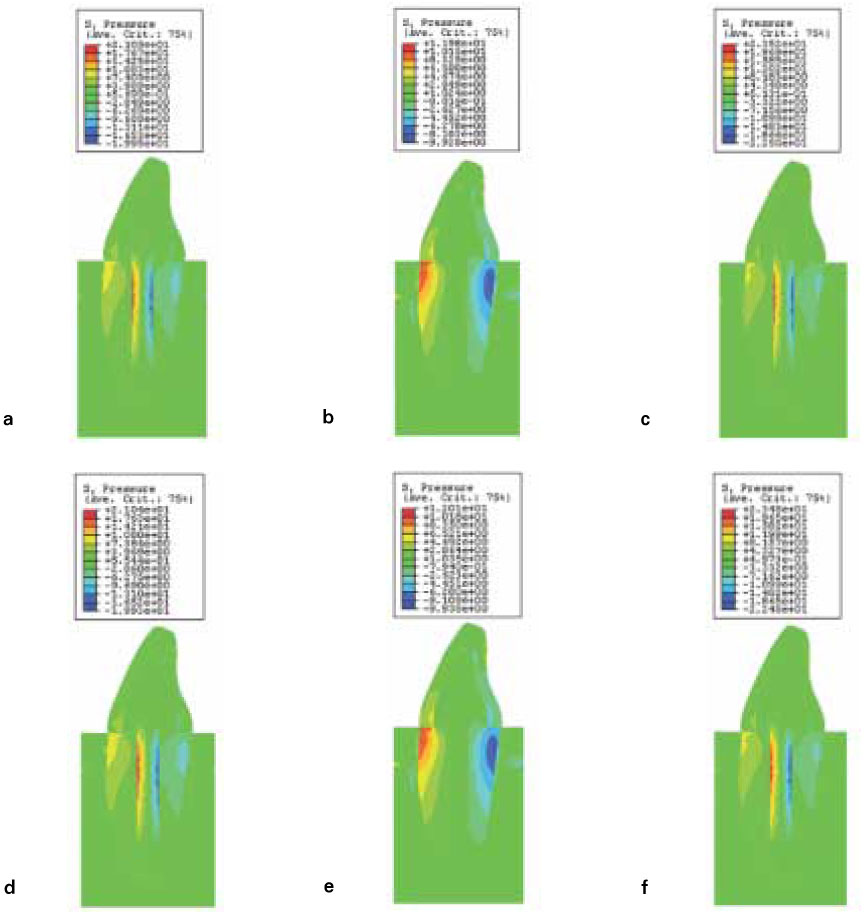J Korean Acad Conserv Dent.
2009 Jul;34(4):324-332. 10.5395/JKACD.2009.34.4.324.
Finite element analysis of maxillary central incisors restored with various post-and-core applications
- Affiliations
-
- 1Department of Conservative Dentistry and Dental Research Institute, School of Dentistry, Seoul National University, Korea. shbaek@snu.ac.kr
- 2Department of Conservative Dentistry, The Institute of Oral Health Science, Samsung Medical Center, Sungkyunkwan University School of Medicine, Korea.
- KMID: 2176161
- DOI: http://doi.org/10.5395/JKACD.2009.34.4.324
Abstract
- The purpose of this study was to investigate the effect of rigidity of post core systems on stress distribution by the theoretical technique, finite element stress-analysis method. Three-dimensional finite element models simulating an endodontically treated maxillary central incisor restored with a zirconia ceramic crown were prepared and 1.5 mm ferrule height was provided. Each model contained cortical bone, trabecular bone, periodontal ligament, 4 mm apical root canal filling, and post-and-core. Six combinations of three parallel type post (zirconia ceramic, glass fiber, and stainless steel) and two core (Paracore and Tetric ceram) materials were evaluated, respectively. A 50 N static occlusal load was applied to the palatal surface of the crown with a 60degrees angle to the long axis of the tooth. The differences in stress transfer characteristics of the models were analyzed. von Mises stresses were chosen for presentation of results and maximum displacement and hydrostatic pressure were also calculated. An increase of the elastic modulus of the post material increased the stress, but shifted the maximum stress location from the dentin surface to the post material. Buccal side of cervical region (junction of core and crown) of the glass fiber post restored tooth was subjected to the highest stress concentration. Maximum von Mises stress in the remaining radicular tooth structure for low elastic modulus resin core (29.21 MPa) was slightly higher than that for high elastic modulus resin core (29.14 MPa) in case of glass fiber post. Maximum displacement of glass fiber post restored tooth was higher than that of zirconia ceramic or stainless steel post restored tooth.
MeSH Terms
Figure
Cited by 1 articles
-
Influence of post types and sizes on fracture resistance in the immature tooth model
Jong-Hyun Kim, Sung-Ho Park, Jeong-Won Park, Il-Young Jung
J Korean Acad Conserv Dent. 2010;35(4):257-266. doi: 10.5395/JKACD.2010.35.4.257.
Reference
-
1. de Castro Albuquerque R, Polleto LT, Fontana RH, Cimini CA. Stress analysis of an upper central incisor restored with different posts. J Oral Rehabil. 2003. 30:936–943.
Article2. Hunter AJ, Feiglin B, Williams JF. Effects of post placement on endodontically treated teeth. J Prosthet Dent. 1989. 62:166–172.
Article3. Ottl P, Hahn L, Lower HC, Fay M. Fracture characteristics of carbon fiber, ceramic and non-palladium endodontic post systems at monotonously increasing loads. J Oral Rehabil. 2002. 29:175–182.
Article4. Ko CC, Chu CS, Chung KH, Lee MC. Effects of posts on dentin stress distribution in pulpless teeth. J Prosthet Dent. 1992. 68:421–427.
Article5. Assif D, Gorfil C. Biomechanical considerations in restoring endodontically treated teeth. J Prosthet Dent. 1994. 71:565–567.
Article6. Caputo AA, Standlee JP. Biomechanics in Clinical Dentistry. 1987. Chicago: Quinte ssence Publishing Co, Inc;185–203.7. Rosentritt M, Furer C, Behr M, Lang R, Handel G. Comparison of in vitro fracture strength of metallic and tooth-coloured posts and cores. J Oral Rehabil. 2000. 27:595–601.
Article8. Yaman SD, Alacam T, Yamen Y. Analysis of stress distribution in a maxillary central incisor subjected to various post and core applications. J Endod. 1998. 24:107–111.
Article9. Holmes DC, Diaz-Arnold AM, Leary JM. Influence of post dimension on stress distribution in dentin. J Prosthet Dent. 1996. 75:140–147.
Article10. Pegoretti A, Fambri L, Zappini G, Bianchetti M. Finite element analysis of a glass fibre reinforced composite endodontic post. Biomaterials. 2002. 23:2667–2682.
Article11. Eskitascioglu G, Belli S, Kalkan M. Evaluation of two post core systems using two different methods (fracture strength test and a finite elemental stress analysis). J Endod. 2002. 28:629–633.
Article12. Boschian Pest L, Guidotti S, Pietrabissa R, Gandliani M. Stress distribution in a post-restored tooth using the three-dimensional finite element method. J Oral Rehabil. 2006. 33:690–697.
Article13. Manning KE, Yu DC, Yu KC, Kwan EW. Factors to consider for predictable post and core buildups of endodontically treated teeth. Part II: clinical application of basic concepts. J Can Dent Assoc. 1995. 61:696–701. 703705–707.14. Sorrentino R, Salameh Z, Apicella D, Auriemma T, Zarone F, Apicella A, Ferrari M. Three-dimensional finite element analysis of stress and strain distributions in post-and-core treated maxillary central incisors. J Adhes Dent. 2007. 9:527–536.15. Sorrentino R, Aversa R, Ferro V, Auriemma T, Zarone F, Ferrari M, Apicella A. Three-dimensional finite element analysis of strain and stress distributions in endodontically treated maxillary central incisors restored with different post, core and crown materials. Dent Mater. 2007. 23:983–993.
Article16. Pierrisnard L, Bohin F, Renault P, Barquins M. Corono-radicular reconstruction of pulpless teeth: a mechanical study using finite element analysis. J Prosthet Dent. 2002. 88:442–448.
Article17. Asmussen E, Peutzfeldt A, Sahafi A. Finite element analysis of stresses in endodontically treated, dowel-restored teeth. J Prosthet Dent. 2005. 94:321–329.
Article18. Eskitascioglu G, Usumez A, Sevimay M, Soykan E, Unsal E. The influence of occlusal loading location on stresses transferred to implant- supported prostheses and supporting bone: A three-dimensional finite element study. J Prosthet Dent. 2004. 91:144–150.
Article19. Park JK, Hur B, Kim SK. The influence of combining composite resins with different elastic modulus on the stress distribution of class V restoration: A three-dimensional finite element study. J Korean Acad Conserv Dent. 2008. 33:184–197.
Article20. Park CS, Hur B, Kim KH, Son K, Park JK. The influence of occlusal load on stress distribution of cervical composite resin restorations: A three-diemnsional finite element study. J Korean Acad Conserv Dent. 2008. 33:246–257.
Article21. Sorensen JA, Engelman MJ. Ferrule design and fracture resistance of endodontically treated teeth. J Prosthet Dent. 1990. 63:529–536.
Article22. Ausiello P, Gee AJ, Rengo S, Davidson CL. Fracture resistance of endodontically treated premolars adhesively restored. Am J Dent. 1997. 10:237–241.23. Sahafi A, Peutzfeldt A, Ravnholt G, Asmussen E, Gotfredsen K. Resistance to cyclic loading of teeth restored with posts. Clin Oral Investig. 2005. 9:84–90.
Article24. Eraslan O, Aykent F, Yücel MT, Akman S. Finite element analysis of the effect of ferrule height on stress distribution at post-and-core restored all-ceramic anterior crowns. Clin Oral Investig. 2008. 08. 12. [Epub ahead of print].25. Ho MH, Lee SY, Chen HH, Lee MC. Three-dimensional finite element analysis of the effects of posts on stress distribution in dentin. J Prosthet Dent. 1994. 72:367–372.
Article26. Mannocci F, Ferrari M, Watson TF. Intermittent loading of teeth restored using quartz fiber, carbon-quartz fiber, and zirconium dioxide ceramic root canal posts. J Adhes Dent. 1999. 1:153–158.27. Asmussen E, Peutzfeldt A, Heitmann T. Stiffness, elastic limit, and strength of newer types of endodontic posts. J Dent. 1999. 27:275–278.
Article28. Toksavul S, Zor M, Toman M, Gunror MA, Nergiz I, Artunc C. Analysis of dentinal stress distribution of maxillary central incisors subjected to various post-and-core applications. Oper Dent. 2006. 31:89–96.
Article29. Park JK, Hur B, Kim SK. Stress distribution of class composite resin restorations A three-dimensional finite element study. J Korean Acad Conserv Dent. 2008. 33:28–38.
Article30. Barjau-Escribano A, Sancho-Bru JL, Forner-Navarro L, Rodriguez-Cervantes PJ, Perez-Gonzalez A, Sanchez-Marin FT. Influence of prefabricated post material on restored teeth: fracture strength and stress distribution. Oper Dent. 2006. 31:47–54.
Article
- Full Text Links
- Actions
-
Cited
- CITED
-
- Close
- Share
- Similar articles
-
- Finite element analysis of the influence of esthetic posts on incisors
- Stress distribution of endodontically treated maxillary second premolars restored with different methods: Three-dimensional finite element analysis
- A three-dimensional Finite element analysis for initial stress of maxillary incisors during activation of upper utility arch wire
- Three-dimensional finite element analysis of the bracket positioning plane in lingual orthodontics
- Influence of Crown Margin Design on the Stress Distribution in Maxillary Canine Restored by All-Ceramic Crown: A Finite Element Analysis

